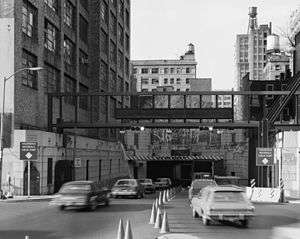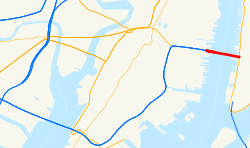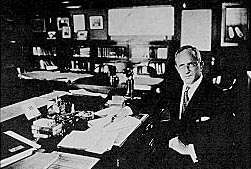Holland Tunnel
The Holland Tunnel is a highway tunnel under the Hudson River between Manhattan in New York City and Jersey City, New Jersey. It carries Interstate 78, and in New Jersey is also designated NJ 139. An integral conduit within the New York Metropolitan Area, the tunnel was originally known as the Hudson River Vehicular Tunnel or the Canal Street Tunnel. It was renamed the Holland Tunnel in memory of Clifford Milburn Holland, the chief engineer, after his untimely death in 1924, before the tunnel was completed. It was to be the first of two vehicular tunnels under the river, the other being the Lincoln Tunnel. Both are operated by the Port Authority of New York and New Jersey.
Description
Begun in 1920 and completed in 1927, the tunnel is named after Clifford Milburn Holland (1883–1924), Chief Engineer on the project, who died before it was completed. Tunnel designer Ole Singstad finished Holland's work. The tunnel is one of the earliest examples of a mechanically ventilated design. Eighty-four fans, in four ventilation buildings, create a floor to ceiling air flow across the roadway at regular intervals, via systems of ducts beneath and above the roadway. The fans can completely change the air inside the tunnel every 90 seconds. A forced ventilation system is essential because of the poisonous carbon monoxide component of automobile exhaust, which constituted a far greater percentage of exhaust gases before catalytic converters became prevalent.[3][4]
The tunnel consists of a pair of tubes, each providing two lanes in a 20-foot (6.1 m) roadway width with 12.5 feet (3.81 m) of headroom. The north tube is 8,558 feet (2,608 m) from end to end, while the south tube is slightly shorter at 8,371 feet (2,551 m).[5] Both tubes are situated in the bedrock beneath the river, with the lowest point of the roadway being about 93 feet (28.3 m) below mean high water.
The amount of traffic going through the Holland Tunnel has remained steady despite tight restrictions on eastbound traffic in response to the September 11 attacks, including a ban on commercial traffic entering New York City put in place after an August 2004 threat.[6][7] The tunnel was used by 34,698,000 vehicles in 2007,[5] according to the Port Authority of New York and New Jersey, the bi-state government agency that owns and operates the Holland Tunnel. That is slightly less than the 34,729,385 vehicles seen in 2006, but up from the 33,964,000 vehicles in 2005.

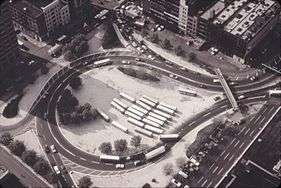
The tunnel was designated a National Historic Civil and Mechanical Engineering Landmark in 1982[8] and a National Historic Landmark in 1993.[9][10][11]
Boyle Plaza
The approach to the Holland Tunnel in Jersey City begins where the Lower Level of NJ 139 and the Newark Bay Extension meet. On May 6, 1936, the section of what became NJ 139/I-78 between Jersey Avenue and Marin Boulevard was named in memory of John F. Boyle, the former interstate tunnel commissioner.[12] Boyle Plaza is the only segment of I-78 and NJ 139 that has stoplights, as it runs concurrent with 12th Street (the eastbound lanes) and 14th Street (the westbound lanes).
The nine-lane toll plaza is equipped with E-ZPass (first made available in October 1997).[5][13]
Holland Tunnel Rotary
Soon after construction of the tunnel, a freight depot, the St. John's Park Terminal, was demolished,[14] and a new circular roadway was created in the city block bounded by Laight, Varick, Beach and Hudson Streets for traffic exiting the eastbound tube in Manhattan.[15][16] Renovations to the rotary, which included adding a fifth exit, were completed in 2004.[17][18][19][20]
Freeman Plaza
Originally used as the toll plazas for New Jersey-bound traffic, the small triangular patches of land at the mouth of the Holland Tunnel entrance had become fenced off by the Port Authority of New York and New Jersey. In 2013, the Hudson Square Connection, the business improvement district for the area, collaborated with the Port Authority to open Freeman Plaza West to the public.[21] Bounded by Hudson, Broome, and Watts Streets, Freeman Plaza West is named after Milton Freeman, the engineer who took over the Holland Tunnel project after the death of Clifford Milburn Holland. It features umbrellas, bistro tables and chairs, and tree plantings.
In 2014, Freeman Plaza East and Freeman Plaza North were opened on Varick and Broome Streets, containing chaise lounge chairs, bistro tables, and umbrellas.[22] In 2016, the Hudson Square Connection added solar powered charging stations to both plazas, and introduced a summer lunchtime music series, called live@lunch.[23]
History
For centuries, passage across the lower Hudson River was possible only by ferry. The first tunnels to be bored below the Hudson River were the Hudson & Manhattan Railroad's uptown and downtown tunnels, constructed in the first decade of the 20th century to link the major railroad terminals in New Jersey with Manhattan Island (they currently run PATH trains). The Pennsylvania Railroad's twin tunnels, constructed to serve the new Pennsylvania Station, soon followed. Once tunneling had been shown to be feasible, increasing automobile traffic led to interest in a roadway crossing the river as well.
The concept for what would become the Holland Tunnel was developed in 1906 by a joint commission between New York and New Jersey. The commission initially considered building a bridge for cost reasons, but this plan was abandoned in favor of a tunnel in 1913 when it was determined that the cost of land for accessways to a suitably raised bridge would be prohibitive as a height of 200 ft (60 m) was considered the minimum necessary to avoid interfering with shipping.[24]
Over the next several years, a number of design proposals were evaluated for the new tunnel. The first two called for a single tube containing two levels of traffic. One, authored by engineer George Goethals specified that traffic on each level would travel in a different direction. The other, by the firm Jacobs and Davies, called for a slightly different tube diameter, with an "express" level and a level for slower traffic. Both designs were eventually passed over in favor of a new type of design proposed by engineer Clifford Milburn Holland, in which two separate tubes would each contain two lanes both going in the same direction. Holland's proposal was adopted, and he was named Chief Engineer of the project.[25] Promotional materials compared the diameter and capacity of the proposed tunnel with the smaller-diameter railroad tunnels.
In 1920, the New Jersey Interstate Bridge and Tunnel Commission and the New York State Bridge and Tunnel Commission appropriated funds for what was then referred to as the "Hudson River Vehicular Tunnel Project". Construction began on March 31, 1922, with a crew of workers starting digging at the corner of Canal Street and West Street.[26] On October 27, 1924, the day before the two halves of the tunnel were scheduled to be linked, 41-year-old Holland died of a heart attack in a sanatorium in Battle Creek, Michigan, attributed by individuals cited in The New York Times to the stress he endured overseeing the tunnel's construction. "Holing through" ceremonies scheduled for that day, in which President Calvin Coolidge would have remotely set off an explosion to connect the two sides of the tunnel, were canceled out of respect for Holland's death.[27]
The project was renamed the Holland Tunnel in memory of its first chief engineer by the New York State Bridge and Tunnel Commission and the New Jersey Interstate Bridge and Tunnel Commission on November 12, 1924.[8] Holland was succeeded by Milton Harvey Freeman, who died of pneumonia in March 1925, after several months heading the job.[28] After Freeman's death, the position was occupied by Ole Singstad, who oversaw the completion of the tunnel and designed its pioneering ventilation system.[29]
Construction
Tunnel construction required workers to spend large amounts of time in the caisson under high pressure of up to 47.5 pounds per square inch (328 kPa), which was thought to be necessary to prevent river water from entering prior to completion of the tubes. "Sandhogs", as they were termed, entered the tunnel through a series of airlocks, and could only remain inside of the tunnel for a designated time period. On exiting the tunnel, the workers had to undergo controlled decompression to avoid the bends, a condition in which nitrogen bubbles form in the blood from rapid decompression.[30] Fortunately, no workers died as a result of decompression sickness: the work involved "756,000 decompressions of men coming out of the compressed air workings," which resulted in 528 cases of the bends, none fatal.[31][32] Completion of the tunnel took nearly seven years and claimed the lives of 14 workers.
Designing the ventilation system
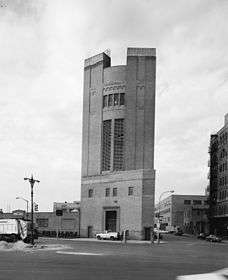
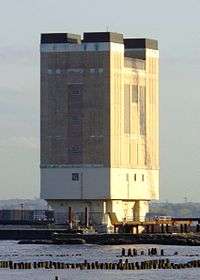
The most significant design aspect of the Holland Tunnel is its pioneering ventilation system. At the time of its construction, underwater tunnels were a well-established part of civil engineering, but no long vehicular tunnel had been built: the technical hurdle was the ventilation required to evacuate the carbon monoxide emissions, which would otherwise asphyxiate the drivers.[32][33][34][35][36][37][38]
There are four ventilation towers serving the two tubes of the tunnel, designed by Norwegian architect Erling Owre.[39]
Thomas Edison had contended it was impossible to ventilate a tunnel with the volume of traffic envisioned for the Holland Tunnel.[40] Previously, tunnels had been ventilated longitudinally. Engineer Ole Singstad pioneered a system of ventilating the tunnel transversely.
Working with Yale University and the United States Bureau of Mines, Singstad built a test tunnel in the bureau's experimental mine at Bruceton, Pennsylvania, over 400 feet (122 m) long—where cars were lined up with engines running. Volunteer students were supervised as they breathed the exhaust in order to confirm air flows and tolerable carbon-monoxide levels by simulating different traffic conditions, including backups. Singstad concluded that a conventional, longitudinal ventilation system would have to be pressurized to an air flow rate of 27 cubic meters per second (953 cu ft/s) on along the tunnel.[40]
Singstad confirmed the feasibility of a tri-level tunnel with the large middle section accommodating vehicles and two plenums, a lower and upper plenum each respectively supplying fresh air and exhausting fumes at regular intervals—solving the ventilation problem.[40]
On opening day the average carbon monoxide content in both tunnels was 0.69 part per 10,000 parts of air. The highest was 1.60 parts per 10,000. The permissible standard was 4 parts per 10,000 parts of air.[41] The public and the press proclaimed air conditions were better in the tube than in some streets of New York City.[41]
Operational history
20th century
The tunnel opened on November 13, 1927, with President Coolidge ceremonially opening the tunnel from his yacht by turning the same key that had "opened" the Panama Canal in 1915, Time magazine called it "the golden lever of the Presidential telegraphic instrument"—which rang a giant brass bell at the tunnel's entrances that triggered American flags on both sides of the tunnel to separate. Vehicles were allowed to pass through the tunnel at one minute after midnight, with the widows of Chief Engineers Holland and Freeman in the second toll-paying vehicle.[3] The tunnel was an immediate success. On its first day of operation, 51,694 vehicles passed through, paying a 50 cent toll ($6.82 today) per car, with tolls ranging from 25 cents for a motorcycle to two dollars for large trucks, which was intended to defray the tunnel's $48 million price tag ($3.3 billion today).[3][42] In 1930, control but not real property title of the tunnel was passed to the Port Authority of New York and New Jersey, which continues to operate it today.[43] Between the 1927 opening and 2005, an additional $536 million has been invested in maintaining the tunnel.
Horsedrawn vehicles have always been banned from the tunnel. A few months before the tunnel's opening, there were suggestions that pedestrians would be allowed to cross the tunnel if they paid a toll described as "not encouraging," but no further mention of this was ever made.[44]
In 1955 a very narrow one-man miniature electric car was developed and installed so policemen could patrol the full length of the tunnel from the catwalk on the side of the tunnel instead of having to walk it. By use of a swivel seat the policemen could drive the car in either direction.[45]
21st century
Between 2003 and 2006, the fire protection system in both tunnels was modernized. Temporary fire extinguishers were located in alcoves along the tunnel walls while the water supply was turned off.[46]
The Holland Tunnel was closed on October 29, 2012 as Hurricane Sandy approached. The tunnel, like many other New York City tunnels, was flooded by the high storm surge. It remained closed for several days, opening for buses only on November 2 and to all traffic on November 7.[47][48]
Accidents and terrorism
In 1949, a fire aboard a chemical truck caused enormous damage to the south tube of the tunnel.[49] The fire resulted in 66 injuries and nearly $600,000 worth of damage to the structure. In addition, two first responders, a FDNY battalion chief and a Port Authority patrolman, died as a result of injuries sustained in fighting the fire.[50] As a result, the Port Authority adopted a strict series of rules on the transportation of hazardous materials within the tunnel.
The tunnel is considered by some high ranking government officials to be one of the most high-risk terrorist target sites in the United States. Other such sites in New Jersey include the PATH station at Exchange Place, which is also in Jersey City; the Lincoln Tunnel, which connects nearby Weehawken to Manhattan; and the Port of Newark in Elizabeth.[51]
Following the September 11 attacks on the World Trade Center, the tunnel remained closed to all but emergency traffic for over a month. When it reopened on October 15, 2001, strict new regulations were enacted banning single-occupancy vehicles and trucks from entering the tunnel.[52] Single-occupant vehicles were prohibited in the tunnel on weekday mornings between 6:00 am and 10:00 am until November 17, 2003, when the restrictions were lifted.[53] Commercial vehicles in classes 1, 2 and 3 (two- and three-axle single-unit trucks) are permitted to travel in both directions of the tunnel at all times. The ban on tractor-trailers and larger trucks in classes 4, 5 and 6 (four-, five- and six-axle trucks) remains in effect in both directions at all times. The ban on trailers and towed vehicles remains in effect in both directions at all times.
Cell phone service was turned off after a series of terrorist bombings occurred in London on July 7, 2005, but was reinstated a few days later.
On July 7, 2006, a plot to detonate explosives in the tunnels of the PATH (initially said to be a plot to bomb the Holland Tunnel) was uncovered by the Federal Bureau of Investigation. In a later update of the source,[54] the plot was clarified to be aimed not at the Holland Tunnel but at the PATH.
Tolls
As of December 6, 2015, the cash tolls going from New Jersey to New York are $15 for cars and motorcycles; there is no toll for passenger vehicles going from New York to New Jersey. E-ZPass users are charged $10.50 for cars and $9.50 for motorcycles during off-peak hours (outside of 6–10 a.m. and 4–8 p.m. on the weekdays; and outside of 11 a.m.–9 p.m. on the weekends) and $12.50 for cars and $11.50 for motorcycles during peak hours (6–10 a.m. and 4–8 p.m. on the weekdays; and 11 a.m.–9 p.m. on the weekends).[55]
See also
- Transportation in New York City
- List of fixed crossings of the Hudson River
- List of tunnels documented by the Historic American Engineering Record in New York
- List of bridges, tunnels, and cuts in Hudson County, New Jersey
References
Notes
- ↑ "2010 NYSDOT Traffic Data Report" (PDF). New York State Department of Transportation. Appendix C. Retrieved February 27, 2010.
- ↑ National Park Service (2008-04-15). "National Register Information System". National Register of Historic Places. National Park Service.
- 1 2 3 "Science: Holland Tunnel". Time. November 21, 1927. Retrieved September 25, 2008.
- ↑ "Compressed Air's Greatest Triumph". Popular Science Monthly: 25. January 1928. Retrieved November 21, 2011.
- 1 2 3 Holland Tunnel Statistics, Port Authority of New York and New Jersey. Accessed September 25, 2008.
- ↑ Weekly Traffic Advisory, Port Authority of New York and New Jersey. Accessed September 25, 2008.
- ↑ McFadden, Robert D.; Dao, James (August 3, 2004). "THREATS AND RESPONSES: THE OVERVIEW; At 5 Buildings, A Day of Pluck And Patience". The New York Times. Retrieved September 25, 2008.
- 1 2 "Holland Tunnel". ASCE Metropolitan Section. Retrieved November 12, 2016.
Resolved, that the Hudson River Vehicular Tunnel ... is hereby dedicated to the memory of Clifford Milburn Holland, and that the said Hudson River Vehicular Tunnel is hereby designated and named as The Holland Tunnel
- ↑ "Holland Tunnel National Historic Landmark summary listing". National Park Service. September 11, 2007.
- ↑ Lange, Robie, S. (March 1993). "Holland Tunnel National Historic Landmark Nomination" (PDF). National Park Service.
- ↑ "Holland Tunnel National Historic Landmark Nomination—Accompanying 12 photos, from 1927–1992" (PDF). National Park Service. March 1993.
- ↑ "Boyle Plaza Dedicated". The New York Times. May 6, 1936. p. 26. Retrieved May 29, 2010.
- ↑ Halbfinger, David M. (October 27, 1997). "E-Z Pass to Start at Hudson River Tunnels". The New York Times. Retrieved September 25, 2008.
- ↑ "Park of the Past". New York Parks Department. October 8, 2005. Retrieved 2014-12-23.
- ↑ "Holland Tunnel Rotary" (PDF). Ives Architecture Studio. Retrieved 2015-01-03.
- ↑ White, Norval; Elliot Willensky; Fran Leadon (2010). AIA Guide to New York City. Oxford University Press. p. 65. ISBN 978-0-19-538386-7.
- ↑ "REHABILITATION OF HOLLAND TUNNEL NEW YORK EXIT PLAZA TO BEGIN THIS MONTH". PANYNJ. March 20, 2003. Retrieved 2014-12-29.
- ↑ "PORT AUTHORITY COMPLETES HOLLAND TUNNEL ROTARY IMPROVEMENTS". PANYNJ. December 29, 2004. Retrieved 2014-12-29.
- ↑ "HT-412 Rehabilitation of the NY Exit Plaza and Holland Tunnel Rotary". Amercom. Retrieved 2015-01-03.
- ↑ "Holland Tunnel Rotary". Studio 5 Partnership. Retrieved 2015-01-03.
- ↑ Karni, Annie. "Pretty plaza sprouts in Hudson Square". Crain's New York Business. Retrieved 2016-06-27.
- ↑ "Small Parks With Chaise Lounges Open Near Holland Tunnel Entrance". DNAinfo New York. Retrieved 2016-06-27.
- ↑ "live@lunch | The Hudson Square Connection a Business Improvement District". Retrieved 2016-06-27.
- ↑ Holland Tunnel Historical Photos, Port Authority of New York and New Jersey. Accessed September 25, 2008.
- ↑ Holland Tunnel Historic Overview, nycroads.com. Accessed September 25, 2008.
- ↑ "Work Begins Today on Jersey Tunnel". The New York Times. March 31, 1922. p. 18. Retrieved May 29, 2010.
- ↑ "C. M. Holland Dies After Breakdown". The New York Times. October 28, 1924. p. 23. Retrieved May 29, 2010.
- ↑ "Another Engineer Dies on Big Tunnel Job; M.H. Freeman Is Victim of Acute Pneumonia". The New York Times. March 26, 1925. p. 1. Retrieved May 29, 2010.
- ↑ Krebs, Albin (December 9, 1969). "Ole Singstad, 87, Master Builder Of Underwater Tunnels, Is Dead". The New York Times. Retrieved May 29, 2010.
- ↑ Kindwall, Eric P (1997). "Compressed air tunneling and caisson work decompression procedures: development, problems, and solutions". Undersea and Hyperbaric Medicine Journal. 24 (4): 337–45. PMID 9444066. Retrieved March 11, 2009.
- ↑ Singstad, Ole (September 1928). Norwegian-American Technical Journal. 1 (3): 1–3, 10. Missing or empty
|title=(help) - 1 2 "Saga in Steel and Concrete, pp. 181–190". Retrieved 4 October 2014.
- ↑ "Saga in Steel and Concrete, pp. 191–202". Retrieved 4 October 2014.
- ↑ "Studies and Methods Adopted for Ventilating the Holland Vehicular Tunnels". Engineering News-Record. 98. 1927-06-09. pp. 934–939.
- ↑ "Ventilating the Holland Vehicular Tunnel". Heating and Ventilating Magazine. 23 (79). August 1926.
- ↑ Singstad, Ole. "Ventilation of Vehicular Tunnels". Proceedings of the World Engineering Congress. 9. pp. 381–399.
- ↑ Davis, A. C. (October 1930). "Development of the ventilation system of the Holland Tunnel". Heating, Piping and Air Conditioning. 2. pp. 866–874.
- ↑ Fieldner, A.C.; Henderson, Y.; Paul, J.W.; others (February 1927). "Ventilation of vehicular tunnels (Report of U.S. Bureau of Mines to New York State Bridge and Tunnel Commission and New Jersey State Bridge and Tunnel Commission)". American Society of Heating and Ventilating Engineers.
- ↑ Gomez, John (April 10, 2012), "Brilliant design in Modernist towers that ventilate the Holland Tunnel: Legends & Landmarks", The Jersey Journal, retrieved 2012-08-12
- 1 2 3 "Ingeniør Ole Singstad (1882–1969)" (in Norwegian). Historier.Norway.
- 1 2 "Saga in Steel and Concrete: Norwegian Engineers in America". 1947.
- ↑ Barron, James (June 27, 1994). "A Tunnel? Holland Named U.S. Historic Landmark". The New York Times. Retrieved September 25, 2008.
- ↑ "History – Holland Tunnel". Port Authority of New York and New Jersey. Retrieved May 29, 2010.
- ↑ Walker, Waldo (August 21, 1927). "Holland Tube Roadways Involve a Huge Task". The New York Times. p. XX10. Retrieved May 29, 2010.
- ↑ "Police Car Rides Narrow Gauge Track Catwalk in Tunnel". Popular Mechanics. March 1955. p. 100.
- ↑ "Traffic Advisory – Holland Tunnel Rehabilitation Work to Begin Monday, October 18" (Press release). Port Authority of New York and New Jersey. October 14, 2004. Retrieved September 25, 2008.
- ↑ "New York transit, commuter lines turning the corner". Politico. Retrieved 2 November 2012.
- ↑ "Holland Tunnel reopens Wednesday after Sandy". WABC TV. Retrieved 7 November 2012.
- ↑ Spiegel, Irving (May 14, 1949). "Chaotic Scenes in Tunnel Described by the Injured; Views Inside the Holland Tunnel Following Chemical Explosion and Series of Fires Yesterday". The New York Times. p. 1. Retrieved May 29, 2010.
- ↑ Jackson, Robert W. (2011). Highway under the Hudson: A History of the Holland Tunnel. New York: NYU Press. p. 179. ISBN 0-8147-4299-8.
- ↑ Pope, Gennarose (February 5, 2012). "Two most dangerous miles in U.S.". The Union City Reporter. Archived from the original on 2012-02-19.
- ↑ Gilbert, Pat R. (October 16, 2001). "Traffic's a Breeze As Holland Tunnel Reopens". The Record. Hackensack, NJ. Retrieved September 25, 2008.
- ↑ "2003 Manhattan River Crossings" (PDF). New York City Department of Transportation. February 2005. Retrieved September 26, 2008.
- ↑ Foreign Plot to Bomb Holland Tunnel Thwarted – Updated, Threat Watch
- ↑ "New Toll Fare Rates for the Bridges & Tunnels Effective December 6, 2015 at 3:00 AM". Port Authority of New York & New Jersey. Retrieved 2015-11-23.
Further reading
- Jackson, Robert W. (2011). Highway Under the Hudson: A History of the Holland Tunnel. New York: New York University Press. ISBN 0-8147-4299-8.
- Holland Tunnel from NYCRoads.com
- The Holland Tunnel, New York Daily News, Wednesday, February 25, 2009
- miNYstory documentary on Holland Tunnel
External links
| Wikimedia Commons has media related to Holland Tunnel. |
- Port Authority of New York & New Jersey: Holland Tunnel
- Historic American Engineering Record (HAER) No. NY-161, "Holland Tunnel, Beneath Hudson River between New York & Jersey City, New York, New York County, NY"
